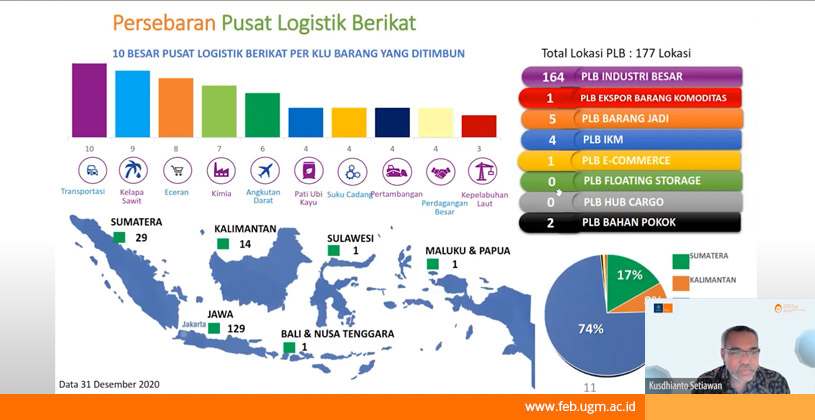Assessing the Effectiveness of Customs Logistics Facilities in Indonesia
- Details
- Written by Kirana
- Category: News
- Hits: 1622

Seeing the importance of supply chain resilience in dealing with disruptions such as the Covid-19 pandemic and managing the complexity of a business' supply chain, it is necessary to disseminate knowledge regarding this matter. One form of knowledge dissemination is the dissemination of research results related to the topic. As part of this effort, the Field of Logistics and Supply Chain Management Studies of FEB UGM designed an annual routine dissemination program called MLRP Impact. MLRP Impact in 2021 titled as MLRP 2021 Research Exposure and the 3rd series was held on Thursday (30/12) with the topic of the event “The Effectiveness of Bonded Warehouse and Logistics Center in Indonesia.”
In this third series, before presenting the results of research related to the topic of the event, first there is a presentation by the speaker from the Directorate General of Customs and Excise (DGCE), Untung Basuki, who is a Director of Facilities. The material presented was titled as “Measuring the Effectiveness of Fiscal Incentive Policies.” He explained that one of the main functions of DGCE is to provide facilitation to the world of industry and trade in order to encourage economic growth. The facilities provided can be in the form of facilitation of fiscal incentives in the form of a bonded zone.
Furthermore, Untung Basuki explained that the purpose of providing customs facilities was to attract investment, increase exports, production cost efficiency, and logistics cost efficiency. In order to ensure that incentives run effectively and that the expected outputs can be achieved, there is a grand design framework for evaluating the process of implementing these fiscal incentives. Based on his presentation, this evaluation/monitoring system needs to be carried out by optimizing the synergy and collaboration of the Ministry of Finance with researchers from academic institutions.
One form of collaboration to evaluate the performance of customs facilities was carried out involving DGCE and the MLRP FEB UGM Research Advisory Team. The results of the research were then presented by Kusdhianto Setiawan, Ph.D., in his presentation titled as “Evaluation of the Effectiveness of Customs Facilities in the Logistics Sector (Bonded Warehouses and Bonded Logistics Centers).” He explained that Indonesia's logistics costs were relatively high compared to other countries, especially when it was exacerbated by the Covid-19 pandemic. Therefore, the Indonesian government seeks to increase the effectiveness of logistics and transportation costs by creating bonded areas in the form of bonded warehouses and bonded logistics centers.
Based on Kusdhianto's explanation, the research was carried out aimed at evaluating the effectiveness of bonded warehouses and bonded logistics centers which were first conducted for the 2019-2020 measurement period. This research will answer several questions such as how these facilities influence the company's performance and the company's import efficiency. The research implementation method involved 163 bonded warehouse respondents and 122 bonded logistics center respondents through a series of interviews and questionnaires.
Kusdhianto also showed the results of a survey of 70% of respondents who agreed with all applicable bonded zone policies, so that the implementation of these policies is still needed and needs to be maintained. In general, the implementation of bonded zones has been going well, but it is still necessary to analyze the constraints and solutions for companies experiencing problems. In addition, companies that implement bonded warehouse facilities and bonded logistics centers have also proven to increase their import efficiency and have the ability to recover from the impact of the Covid-19 pandemic five times faster than other companies.
Reportase: Kirana Lalita Pristy.


